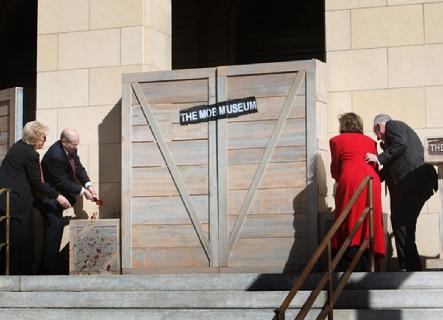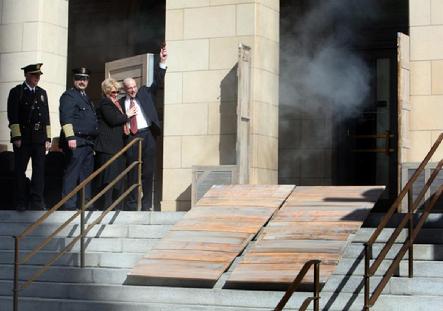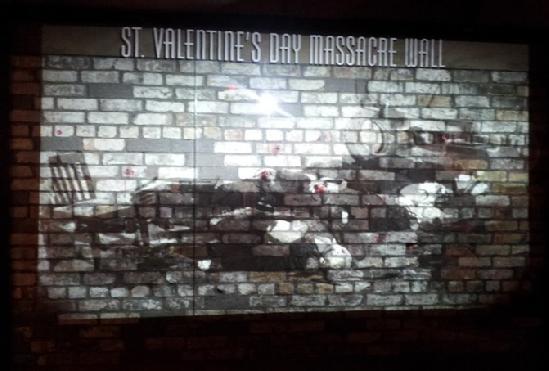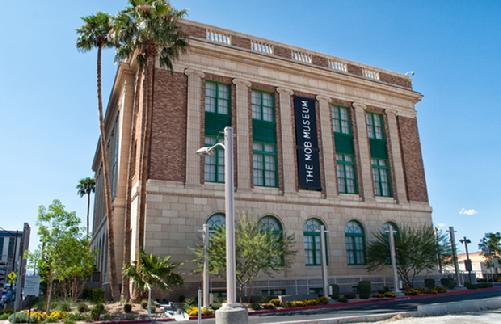Important Message
This Website Terms and Condition of Use Agreement
also known as a 'terms of service agreement'
Will be at the bottom of most web pages!
Please read it before using this website.
Thank You
|
The National Museum of Organized Crime
|
At the Mob Museum, You can see it all - the good guys and the bad, the truth and the fiction, life and death. The history of the mob is brought to life through displays, artifacts, theater, and location.
|
Displays– From the “Wall of Mobsters” to individual exhibits that portray the criminal lives of famous mobsters, including Al Capone, Lucky Luciano, Bugsy Seigel, Meyer Lansky, and Whitey Bulger, the mob museum tells the life stories of many a famous gangster. The museum is not just a shrine for mob members, it promotes the heroic efforts of countless police officers who fought back against illegal mob activities.
• Artifacts – The most prized artifact at the Mob Museum is the wall before which the St Valentine’s Day Massacre took place. Masterminded by Al Capone, one of the most recognizable
gangsters in American history, the St. Valentine's Day Massacre took place in Chicago on February 14, 1929. Five members of the gang that controlled the North side of Chicago were lined up against the back wall of a garage and were killed along with two other individuals. Most people believe that they were killed by members of Al Capone’s rival South Side gang. This is only one of many interesting artifacts that are connected to mob history and the government's battle against the control of crime syndicates around the country.
• Location – The Kefauver Committee was set up in the early 1950’s to investigate the activities of mob organizations and their influence interstate commerce in this country. The investigations were thorough and complete. But after 14 hearings in various cities across the country, and interviewing hundreds of witnesses, including many mob members, the committee recommendations were somewhat limited. However, it did recommend that the justice department investigate 33 individuals suspected of being leaders in organized crime in the United States. In Las Vegas, the committee interviewed only six people, gaining very little information. It was in the Federal Court House at 300 East Stewart Street where the interviews and hearing were held, and that very room now stands recreated as part of the Mob Museum. Las Vegas in many ways was built upon the myth and the legend of the mob, as well as the cash and vision of the mobsters who helped to make the Las Vegas of today!
|
The recently opened Mob Museum in Las Vegas is one of the most thorough and interesting exhibits I have ever seen. It encompasses 3 big floors, and commands about 3 hours of your time. Located in the historic former federal courthouse and US Post Office building near Fremont Street, this is where Las Vegas began nearly 100 years ago.
The landscape of Las Vegas changes rapidly, that is part of the allure of it being a destination city. When Congress approved the 18th Amendment banning alcohol in 1920, organized crime turned to filling a need demanded by the public, supplying illegal alcohol. When the 21st Amendment appealed prohibition in 1933, crime organizations needed a new vice, and gambling rose to the forefront. Gangsters needed new turf, so they headed west to a quiet little desert city on the verge of exploding into a giant.
Al Capone, Meyer Lansky, and Bugsy Siegel were early players in the gambling underground. Siegel built the first big gaming hotel in Las Vegas, The Flamingo. The Mob Museum tells the entire early history of Las Vegas, covering every shady character that ever graced the stage in the desert city. You will see artifacts from all the big name gangsters including the original blood soaked, bullet holed brick wall that was the original backdrop (and target) of Chicago’s famous St Valentine’s Day Massacre.
As your journey continues through The Mob Museum, you will also experience the other side of the story. The G-Men were the law and order side of federal, state and local governments, who worked cohesively to stop the gangsters. Famous crime fighting figures such as federal agent Eliot Ness with”The Untouchables,” and Senator Ester Kefauver are key focuses of The Mob Museum. You can even sit in the actual courtroom where the (then Congressman) Kefauver crime hearings were held in the early 1950s. You will see confiscated Tommy Guns, arrest records, mugshots, even an electric chair.
You will see high tech exciting films, experience interaction exhibits, and can even go to jail yourself for a realistic mugshot at ‘The Mob Museum’. The legacy of Hollywood’s connection with the portrayal and romancing of organized crime is also well documented. Close by is legendary Fremont Street, where the neon cowboy still winks at you, and even closer are new and trendy lunch or dinner destinations like Triple George Grill, and the Mob Bar, which sports vintage film posters of the gangster era.
The Mob Museum is an excellent way to spend an afternoon.
|
The National Museum of Organized Crime, or the Mob Museum, opened its doors on Tuesday, Feb. 14th, 2012.
The museum, which cost an estimated $42 million to build, is located in the downtown area of Las Vegas and displays the long history of organized crime in the United States. Ironically, its opening date is the anniversary of Chicago's infamous 1929 St. Valentine's Day Massacre.
Now open to the public, the mob museum is under the direction of Dennis Barrie, co-creator of the International Spy Museum in Washington, D.C. In building the museum, Barry included 17,000 square feet of exhibits, including the bullet-riddled brick wall from the infamous Valentine's Day Massacre. The building that houses the organized crime museum is, by no coincidence, a former federal courthouse. In fact, it's the very same courthouse that held the 1950-51 Kefauver Committee hearings, a Senate investigation into the mob and its influence on the nation's economic, political and cultural life.
The mob museum takes visitors on a journey through organized crime from the 1930s to the 1980s. It was during those five decades that the mob was defined by family and ethnic affiliation. It was also the time when law enforcement and the justice system flourished as institutions dedicated to stopping the wave of crime that was spreading throughout the United States.
The museum highlights key events in mob history with exhibits displaying Prohibition-era whiskey flasks and Kennedy-era FBI wiretaps. There's also a page from Meyer Lansky's accounting ledger and suits worn by fictional HBO mob boss Tony Soprano.
The museum will help people understand better where Las Vegas comes from, and where they come from, historian Michael Green, told Reuters. At the same time, they'll also go away thinking, 'Only in Las Vegas could there be a museum like this.'
Check out photos from opening day at the Mob Museum below:
|
 |
| Las Vegas Mayor Carolyn Goodman (L) with Jonathan Ullman, executive director of The Mob Museum, and Ellen B. Knowlton, former FBI special agent in charge of the Las Vegas division, with former Las Vegas Mayor Oscar Goodman (R) open The Mob Museum in Las Vegas. |
|
|
 |
| Las Vegas Mayor Carolyn Goodman and Jonathan Ullman, executive director of The Mob Museum, cheer as the museum is opened in Las Vegas. |
|
|
| St. Valentine's Day Massacre Wall |
|
|
 |
| St. Valentine's Day Massacre Wall - Al Capone Museum Web Site - Click Here |
|
|
|
| Mob Museum Displays & Artifacts |
|
|
 |
| Thanks for stopping by The Mob Museum.. |
|
|
 |
| Next Page |
|
|
This website contains, in various sections, portions of copyrighted material not specifically authorized by the copyright owner. This material is used for educational purposes only and presented to provide understanding or give information for issues concerning the public as a whole. In accordance with U.S. Copyright Law Title 17 U.S.C. Section 107, the material on this site is distributed without profit. More Information
Information presented based on medical, news, government, and/or other web based articles or documents does not represent any medical recommendation or legal advice from myself or West Saint Paul Antiques. For specific information and advice on any condition or issue, you must consult a professional health care provider or legal advisor for direction.
I and West Saint Paul Antiques can not be responsible for information others may post on an external website linked here ~ or for websites which link to West Saint Paul Antiques. I would ask, however, that should you see something which you question or which seems incorrect or inappropriate, that you notify me immediately at floyd@weststpaulantiques.com Also, I would very much appreciate being notified if you find links which do not work or other problems with the website itself. Thank You!
Please know that there is no copyright infringement intended with any part of this website ~ should you find something that belongs to you and proper credit has not been given (or if you simply wish for me to remove it),
just let me know and I will do so right away.
|
Website Terms and Condition of Use Agreement
also known as a 'terms of service agreement'
By using this website, West Saint Paul Antiques . Com, you are agreeing to use the site according to and in agreement with the above and following terms of use without limitation or qualification. If you do not agree, then you must refain from using the site.
The 'Terms of Use' govern your access to and use of this website and facebook pages associated with it. If you do not agree to all of the Terms of Use, do not access or use the website, or the facebook sites. By accessing or using any of them, you and any entity you are authorized to represent signify your agreement to be bound by the Terms of Use.
Said Terms of Use may be revised and/or updated at any time by posting of the changes on this page of the website. Your continued usage of the website, or the facebook site(s) after any changes to the Terms of Use will mean that you have accepted the changes. Also, any these sites themselves may be changed, supplemented, deleted, and/or updated at my sole discretion without notice; this establishes intellectual property rights by owner (myself).
It saddens me to include a Terms of Use for West Saint Paul Antiques . Com, but we all realize it is something that is necessary and must be done these days. By using the website, or facebook for West Saint Paul Antiques, you represent that you are of legal age and that you agree to be bound by the Terms of Use and any subsequent modifications. Your use of the West Saint Paul Antiques sites signify your electronic acceptance of the Terms of Use and constitute your signature to same as if you had actually signed an agreement embodying the terms.
|
|